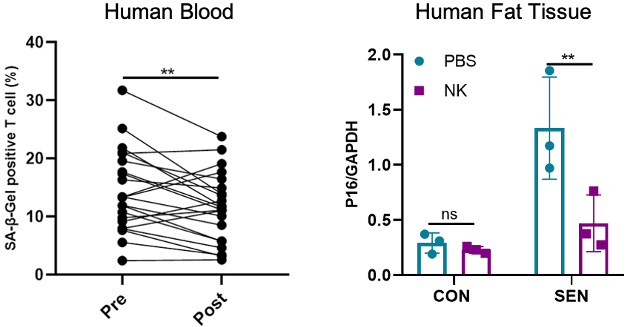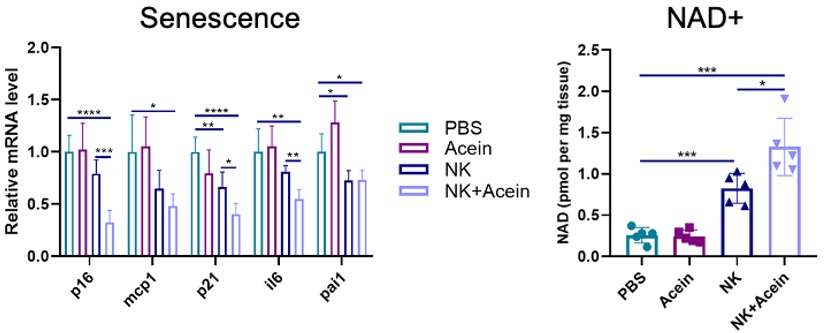Key Points:
- A type of immune cell called a natural killer cell reduces the occurrence of senescence — cell growth arrest — in human blood and fat tissue.
- Elevating dopamine levels enhances the effect of natural killer cells in multiple mouse organs.
- Natural killer cell treatment raises NAD+ levels in mouse fat and liver tissue and is further increased when combined with dopamine elevation.
Senescence is sometimes considered the root cause of age-related disease. Unlike non-senescent, ordinary cells, senescent cells don’t grow and divide, but influence non-senescent cells by secreting molecules known as SASP (senescence-associated secretory phenotype) factors. SASP factors cause inflammtion, thought to underly most age-related diseases, and induce senesence in other cells, spreading the inflammation and speeding up the aging process.
As we age, senescent cells accumulate throughout our bodies, and it hasn’t been clear why. However, a new study suggests that it’s because of declining levels of dopamine — the brain signaling molecule associated with pleasure and reward — and a weakened immune system. Bai and colleagues from China Pharmaceutical University report in Cell Death & Disease that infusion of natural killer cells can eliminate senescent cells, and Acein – a dopamine-releasing peptide — enhances this effect, suggesting that this combo can be used to treat age-related diseases.
Cell Wars
For the study, healthy volunteers aged 36 to 71 received bloodstream infusions (intravenous injections) of natural killer cells — a type of white blood cell that can quickly destroy unwanted cells as part of the adaptive immune response The infusion led to a reduced proportion of senescent immune cells (T cells) circulating in the blood. Additionally, since obesity tends to cause further accumulation of senescent cells, Bai and colleagues analyzed fat tissue from obese individuals ranging from 50- to 65-years-old. They found that natural killer cell treatment reduced senescence and SASP factors, demonstrating that natural killer cells reduce senescence in human tissue.

(Bai et al., 2022 | Cell Death & Disease) Natural Killer Cell Infusion Reduces Senescence in Humans. (left) The percentage of senescent immune cells (SA-β-Gal positive T cell) measured from the blood of 26 individuals decreased after (post) natural killer cell (NK) infusion. (right) A genetic marker for senescence (p16) measured from the fat tissue of 3 obese individuals decreased in response to NK infusion. This was relative to individuals who did not get the NK treatment (PBS) and occurred when fat cells were grown in a dish with SASP factors (SEN), which promote senescence, as opposed to a medium without SASP factors (CON).
Dopamine isn’t just a pleasure and reward neurotransmitter, it’s capable of regulating the communication between the nervous system and the immune system by increasing natural killer cell activity. However, our dopamine levels drop as we grow older. Thus, Bai and colleagues examined whether raising dopamine levels could enhance senescence elimination by adding Acein (10 mg/kg) to the killer cell infusion. This cocktail reduced senescence and SASP factors in old mice’s liver, lung, kidney, and fat tissue more than natural killer cell treatment alone. The results demonstrate that dopamine enhances senescent cell elimination and suggests the targeting of multiple senescent cell types.
Because declining levels of NAD+ — a molecule involved in hundreds of reactions that keep cells vital — is a major consequence of increased senescence during aging, Bai and colleagues measured NAD+ levels in response to natural killer cell and Acein treatment in old mice. They found that natural killer cells alone increased NAD+ in fat and liver tissue. When combined with Acein, the natural killer cell infusion further increased NAD+ levels. These results point to natural killer cell and Acein treatment to boost NAD+, which has been shown to mitigate age-related diseases.

(Bai et al., 2022 | Cell Death & Disease) Dopamine Enhances Natural Killer Cell Treatment in Old Mouse Fat Tissue. (left) Gene activity (relative mRNA level) for senescent and SASP markers (p16, mcp1, p21, il6, and pai1) are decreased with natural killer cell (NK) treatment and further decreased in combination with dopamine (NK + Acein). Dopamine (Acein) alone has the same effect as no treatment (PBS). (right) NK raises NAD+ levels, which are raised further in combination with dopamine. Dopamine alone does not raise NAD+ levels.
To the Death of Senescent Cells
Getting rid of senescent cells has garnered a lot of interest for its anti-aging potential. However, senescent cell elimination isn’t so easy, as these “zombie”-like cells harness defense mechanisms blocking them from dying. Currently, the most successful intervention for killing senescent cells has been senolytics — a class of drugs that circumvent the senescence anti-death system. Many senolytics have the potential to extend lifespan and improve cognition and body function, but different senolytics appear to target unique subsets of cells. Therefore, Bai and colleagues decided to explore methods for safely eliminating a wide range of senescent cell types by using natural killer cells.
Senescent cells are beneficial in the short term because they stop defective cells from populating; when they stick around longer, they become harmful. As such, senescent cells are recognized and removed by the immune system. Indeed, senescent cells activate their own self-demise by attracting natural killer cells. However, with increasing age, the immune system weakens, allowing senescent cells to escape the destruction of natural killer cells. This prompted Bai and colleagues to study the efficacy of natural killer cell infusion on senescence and aging.
Natural Killers on Dopamine
The findings of Bai and colleagues demonstrate the potential of combining natural killer cell and Acein infusion therapy for eliminating senescent cells. This natural killer combo could possibly overcome the obstacle of targeting multiple senescent cell types without as many side effects as senolytics. Recent progress has already been made with natural killer cell infusion and cancer therapy, as natural killer cells also eliminate tumors. If the root of aging is senescent cells, and senescent cells result from a weakened immune system, this would suggest that aging is a mere consequence of low immunity. So it seems that immunotherapies like natural killer cell infusion may be a viable anti-aging strategy. Until then, senolytics like dasatinib and quercetin may be the way to go.